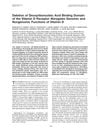Mechanism of Vitamin D Receptor Action
April 2006
in “
Annals of the New York Academy of Sciences
”
TLDR Vitamin D receptor is essential for healthy bones and skin.
The study explored the role of the vitamin D receptor (VDR) in skeletal growth and skin health using VDR knockout mice. It was found that VDR is crucial for normal skeletal development, as VDR null mice exhibited hypocalcemia, hyperparathyroidism, hypophosphatemia, rickets, and osteomalacia. These conditions were preventable with a high-calcium, high-phosphorus, lactose-supplemented diet, which normalized mineral ion homeostasis and prevented bone abnormalities. The study also revealed that the growth plate abnormalities were due to impaired apoptosis of hypertrophic chondrocytes caused by hypophosphatemia. Additionally, the research identified novel ligand-independent actions of VDR in keratinocytes, explaining the alopecia observed in VDR null mice. The skeletal effects were indirect, resulting from the absence of ligand-dependent receptor actions in the intestine, while the skin effects were a direct result of missing ligand-independent VDR actions in the skin.




